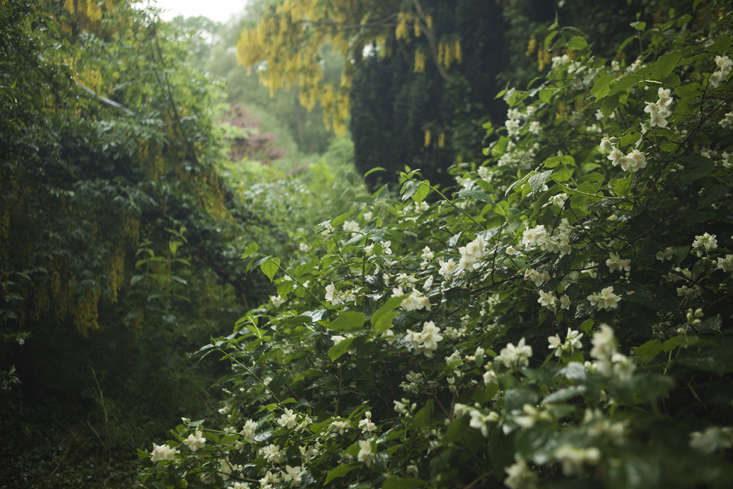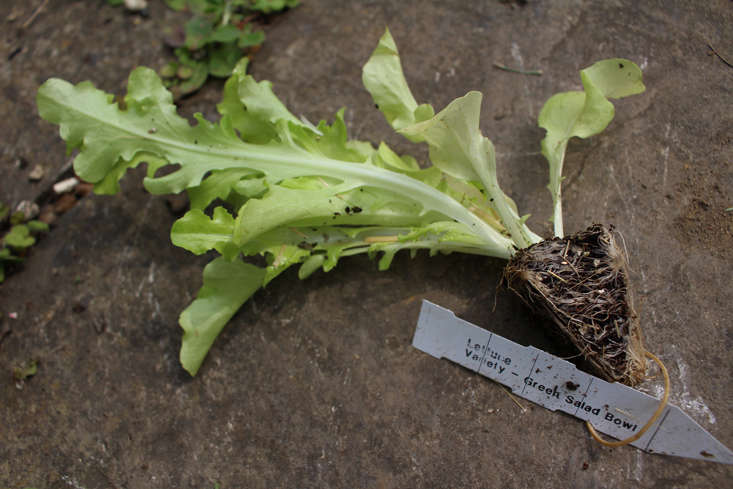Restoring the garden at the Wilderness is pleasantly frightening. This beautiful yet derelict place was once nurtured by one of the best-loved decorators of the 20th century, Nancy Lancaster. She was also famously opinionated, which can be helpful: when faced with a dilemma, it is perfectly sensible to ask, “What would Nancy do?”
Join my friends Annabelle and David as we steer this garden back to its happy place, unearthing style ideas from the past, while addressing the here-and-now. For example: How to feed a family of six this season, from a kitchen garden that grows nothing but nettles.
(N.B.: See the previous installment of this series at Rehab Diary, Part 1: Nancy Lancaster’s Garden at Wilderness House.)
Photography by Jim Powell, except where noted.
Above: Wilderness House, running to seed last summer.
The Garden’s Edge
Above: Laburnum hanging over the remains of the formal parterre.
If there was a ghost at Kelmarsh Hall in Northamptonshire, it would be Nancy Lancaster, who leased it for several decades from the 1920s as Mrs. Tree, before marrying the owner, Colonel Lancaster. With both lease and marriage over, her affection for the house and garden (with a spare house down the road) never died. The spare house is known as the Wilderness.
Laburnum is a classic accessory of many gardens of a certain age. But no—that would be too predictable here. There are actually six laburnums, forming a grove marking the way from a wooden gate by the farm track into the side of the garden. Even this shortcut has been considered and made vastly more interesting than the presence of a once-fashionable tree.
Above: Philadelphus, one of Nancy’s favorites, provides an understory to the laburnum and lights up the garden perimeter by the farm, along with repeats of Viburnum opulus ‘Roseum’. At Kelmarsh Hall, a philadelphus garden is being restored, having been planted by Nancy and allowed to languish after the 1950s. Further mounds of large, scented philadelphus could be used to good effect nearer the house.
The Kitchen Garden
Above: The dilapidated greenhouse, being put to use before it blows away. Photograph by Kendra Wilson.
A few weeks ago, Annabelle had mentioned that she wanted to buy an instant vegetable garden from a company called Rocket Gardens. She’d done it before and it had been wonderful; all she and David had to do was unpack the box and put everything in the ground. I was appalled.
Above: The instant vegetable garden arrives in a large box. Photograph by Kendra Wilson.
A few days after my firm words with Annabelle, Rocket Gardens got in touch, out of the blue, and I responded by saying I’d be willing to give them a try. There was a quick response to say that a Large Vegetable Garden was on its way. This included 40 lettuces and 20 endives, to give an idea of the scale. On reflection, I think that in a post-servant world Nancy would have shared Annabelle’s enthusiasm.
Above: Photograph by Kendra Wilson.
Although the vegetables have been beautifully labelled and packed in straw, we are not being over-scrupulous with our own labelling (which can be checked online). It’s really a case of making use of cleared ground as it becomes available. The vegetable garden is roughly divided into legumes, brassicas, roots, and onions, with much intermingling along the way. The revered vegetable-thinker Joy Larkcom is our guide and in her classic Grow Your Own Vegetables ($18.95 on Amazon) she supplies various four-bed rotation plans, including one for us, the ‘Feed the Family Plan’.
Photograph by Kendra Wilson.
A few tons of topsoil were bought cheaply and that has made a pleasant medium for this instant garden of annuals, if it can survive weed strangulation over the summer. Nettle clearance has breathed new life into the underground network of bindweed. I confess that we are winging it during this first growing season, only planting perennials (such as rhubarb) in ground that has been more beautifully cleansed, with a view to clearing the rest out properly at the end of the season.
Above: Wilderness House, as seen from the sizeable heap of cow manure in the farmyard next door. This is fantastically useful for zucchini, beans, and pumpkins. Over winter, the heap will be greatly reduced in size as we spread it over our four modular beds, ready for a new system of crop rotation next year.
for more, see Rehab Diary, Part 1: Nancy Lancaster’s Garden at Wilderness House.






















Have a Question or Comment About This Post?
Join the conversation (1)